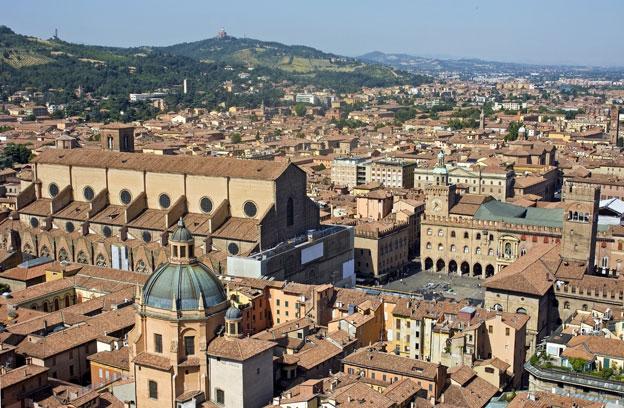Bologna, the capital of the region of Emilia-Romagna, in northern Italy, has a population of approximately 390,000, including 80,000 university students. It is one of the most prosperous and beautiful cities in Italy. In 2000 it became a European Capital of Culture, and in 2006 it was made a UNESCO Creative City of Music.
Bologna has the world’s largest intact medieval city centre. Many of the building façades are painted in bright or muted shades of red, russet, ochre and yellow. It was this beauty which earned the city the nickname of Bologna la Rossa (Bologna the Red) which, since the Second World War, has also come to refer to the popularity of socialism and communism in the city.
Piazza Maggiore, the epicentre of the historic city, was once the site of a Roman forum and is now a venue for regular lively music and arts festivals. The piazza is surrounded by the 13th-century Palazzo Comunale (Town Hall) and Palazzo dei Notai (House of the Notaries), the 14th-century Basilica di San Petronio and the 16th-century Palazzo dei Banchi (Bankers’ House). The Palazzo Comunale houses the Collezioni Comunali d’Arte and the Museo di Giorgio Morandi. Its huge main staircase was designed to be used by horse-drawn carriages. The Basilica di San Petronio is the fifth largest church in the world. The front façade was never completed, and it is believed that this was because the Vatican removed funding when it learned of plans to make the basilica larger and grander than St Peter’s in Rome.

Piazza Maggiore - Bologna
Adjacent to the Piazza Maggiore is the Piazza del Nettuno, at the heart of which is the iconic Fontana di Nettuno (Fountain of Neptune). Overlooking the piazza is the 13th-century Palazzo del Podestà, formerly the main law court of the city, which was largely rebuilt in the 15th century. On the corner of the Piazza Maggiore and the Piazza del Nettuno is the 13th-century Palazzo Re Enzo, named after an illegitimate son of Emperor Frederick II. Enzo was imprisoned here for 22 years by papal loyalists, although he was looked after by servants and was allowed the company of women.
A striking feature of the historic city centre is its network of medieval porticos, under which it is possible to walk long distances whilst protected from heat or rain. In total the porticos extend for about 53 kilometres. The earlier ones came about as the upper floors of houses were extended, supported by wooden columns. Later, most houses in the city were required to be built with porticos, in order to provide shelter for the public. The world’s longest is the Portico di San Luca, built between 1674 and 1739. It includes 666 arches and 15 chapels and extends for 4 km to the 18th-century, circular Santuario della Madonna di San Luca, where there are fine views over the city and countryside.

Due Torri - Bologna
The Torre degli Asinelli and the Torre della Garisenda, known as the Due Torri (Two Towers), were built in the 12th century, at a time when leading families competed to build the highest tower as a display of their wealth and importance. It is believed that up to 100 such towers were built in Bologna, but most have collapsed or been demolished, leaving only 21 remaining today. Some of them began to lean at alarming angles: the Torre della Garisenda, now 48 metres high, leaned to such an extent that its construction had to be abandoned and the top section removed to prevent its collapse. Today it leans more than 3 m and restoration work is being carried out on it. Even the Torre degli Asinelli, built adjacent to it as a replacement, now has an incline of 1.3 m.
Bologna has a strong musical tradition. The University has 4000 students in music disciplines. Alumni of the Conservatorio di Musica G B Martini include Verdi, Puccini and Rossini. Other composers whose works have been performed in Bologna include Mozart, Wagner, Liszt and Brahms. Bologna is one of the most important places in Italy for hosting national and international, traditional and modern music events.
Bologna has become famous for its luxury cars and motorcycles. Maserati sports cars were manufactured in Bologna from 1914 until 1940, when the factory moved to nearby Modena. Lamborghini ‘super sports cars’ have been made in Sant’Agata Bolognese, 25 km from Bologna, since 1963. Ducati motorcycles have been manufactured in Bologna since 1946. There are museums in and around Bologna containing prestigious vintage models of all three.

Bologna is widely regarded as the culinary capital of Italy; it is for good reason that another of Bologna’s nicknames is La Grassa (The Fat). Many types of food originated in Bologna and the surrounding area, including Parmesan cheese, balsamic vinegar and various types of pasta and cured pork products.
Italians appreciate traditional culture as well as modern music, food and fast cars; these contrasting aspects of Italian life are readily apparent in Bologna, known throughout Italy as a hedonistic city even by Italian standards. Bologna is the ideal place where to enjoy true Italian culture.



